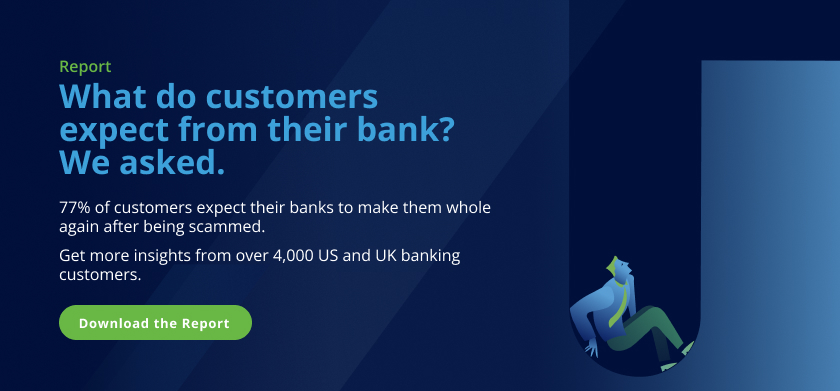Think about your own most recent experience with your bank. Did a scam prevention message catch your attention and stop you in your tracks? Or did you dismiss it without a second thought so you could continue your business? Most likely the latter case. For years, financial institutions have sent generic and often repetitive scam prevention messaging that has become all too easy to ignore.
The world of financial scams is constantly evolving, and so should banks’ defenses against them. The evolution goes beyond technological investments that detect unusual or suspicious activities. While purpose-built scam-prevention technology is critical, banks must also adopt smarter scam prevention messaging efforts to protect customers effectively.
How Smart Warnings Help Banks Reduce Fraud Losses and Keep Customers Safe
3 Common Scam Warning Problems
There are three key pain points with how banks currently approach scam prevention messaging.
- Too Generic. A one-size-fits-all approach to scam prevention messaging is outdated. Today’s customers are inundated with indistinguishable scam alerts. Warnings are often the same whether a payment is made to a regular payee or someone new. Such generic messages are often swiftly dismissed.
- Repetition Leads to Dismissal: Sometimes repetition is the best way to ingrain a lesson. But in the case of scam prevention messaging, it’s numbing. Continuous exposure to identical warnings lulls customers into a false sense of security that they are prepared, but ultimately leaves them unguarded.
- Messages Lack Context: When a scam happens, customers may not even realize it is happening in the moment. Many scam alerts don’t provide the specific information a customer needs to make an informed decision. As a result, people may not recognize the critical warning signs of a scam when they encounter them. Customers need to understand why they receive an alert at a specific point in the process.
If banks can’t communicate effectively with their customers about the threat of scams, the customers may be at risk of falling for a scam. But before banks can upgrade their own messaging, they should first understand how scammers communicate with their targets.
Understanding the Scammer’s Language
Research shows that language is a potent weapon in the field of scams. Scammers employ a variety of linguistic tactics to deceive and compel their victims. These tactics include:
- Urgency and Time Pressure: A highly effective tactic is for scammers to drum up a false sense of urgency with phrases like “Act now!” or “Immediate response required!” to pressure victims into making impulsive decisions.
- Fear and Threats: Fear is also a powerful motivator for scammers. Raising the specter of legal trouble, financial loss, or harm to loved ones compels victims to follow scammers’ instructions.
- Authority and Credibility: By impersonating trusted entities – such as a bank employee, a trusted company, or a public official – scammers can gain victims’ trust using language that implies legitimacy and credibility.
- Flattery and Persuasion: By praising a victim’s intelligence, accomplishments, or financial savvy, the scammer gains their trust, making them vulnerable to manipulation.
- Social Proof and Peer Pressure: Fraudsters imply that victims are part of a special group and that others are already taking advantage of a limited-time offer. This creates a sense of social belonging and peer pressure.
- Deceptive Information and Misdirection: Scammers employ deceptive language, overly technical jargon, and misdirection to confuse victims and make their scams appear legitimate.
- Emotional Appeals: Using emotions such as fear, excitement, greed, or sympathy, fraudsters impair victims’ rational thinking and manipulate their decision-making.
These tactics have proven time and time again to be effective for scammers. If banks want to stop their customers from falling victim to scams, they must adjust their approach with smarter, on-point messaging.
Why Banks Need to Speak Scammers’ Language
With scams reaching epidemic proportions, banks must ensure their messaging reaches the next level.
To combat scams effectively, banks must adapt their approach in the following ways.
1. Recognize Scammers’ Linguistic Patterns
By understanding fraudsters’ linguistic patterns, individuals can become more aware of potential scams. Recognizing tactics like urgency and authority helps identify suspicious communications.
2. Smarter Scam Education
Banks must promote education and awareness about scams and the linguistic tricks scammers use to reduce customers’ susceptibility. Give customers examples of how scams work and use the appropriate communication channels to reach them, like social media or email, based on customers’ preferences. Teach individuals to recognize warning signs and respond safely.
3. Tailored Scam Prevention Interventions
Not all customers are the same. Therefore, banks can’t rely on generic messages to connect with customers at critical junctures in their journeys. Instead, banks must customize their educational content and strategies for specific populations to address unique vulnerabilities. This means having specific messaging targeted to younger people who are more vulnerable to investment scams and other messages to older customers at risk of elder fraud like tech scams.
4. Scam Prevention Collaboration and Partnerships
In the ongoing fight against scams, there is power in numbers. Banks should share their experiences and observations about evolving scam tactics with others to raise awareness of shifting tactics. Banks should frequently collaborate with educational institutions, financial organizations, and law enforcement agencies to develop comprehensive programs and stay ahead of the latest scam threats.
How Feedzai Tackles Scam Prevention Messaging Differently
As longtime fraud and scam prevention experts, Feedzai understands that the bad actors’ tactics constantly evolve. Banks must adjust their messaging strategies to build smarter customers. By investing in smarter customers, banks are ultimately building smarter scam defenses.
Here’s how Feedzai handles scam education differently:
Customer-Centric Messaging
Feedzai believes that the customer is the first line of defense. We focus on making customers smarter and more vigilant, earning their trust through tailored and informative interactions. By understanding who customers are and how they usually behave, banks can deliver the right message to their customers at the right time. This makes banks’ scam prevention messaging more effective and demonstrates to customers that their bank knows who they are and how to best protect them from scams. In other words, smarter scam messaging builds customer trust.
Data-Driven Insights
Understanding who customers are and how they typically behave is critical to giving them the personalized experience they expect. By collecting individual information, banks can understand what’s happening and adapt their messaging accordingly. With this understanding, customers can experience less friction on their banking journey and remain vigilant in the face of new scam threats.
Pooled Scam Knowledge
Feedzai leverages the power of the cloud to formulate learnings and best practices among customers without sharing sensitive information. This aggregated intelligence enhances scam prevention by constantly learning and adjusting strategies based on the latest trends.
Continuous Messaging Improvement
Scam prevention messaging strategy should never be set in stone. Instead, banks should learn and adapt to new developments constantly. For example, let’s say a bank sends a warning to a customer about a transfer to a new contact. The customer responds to assure the bank that the transaction is intentional and trustworthy. Once confirmed and validated by other intelligence, the bank can add this information to its feedback loop to reinforce its risk engine and improve future alerts.
Even though scams are becoming increasingly sophisticated, with the right technology and approach, banks can keep up with the threat. By providing smarter, more personalized scam education based on a customer’s unique behaviors and attributes, banks can empower customers to protect themselves. Smarter messaging results in smarter customers, which ultimately results in smarter defense against scams.
Share this article:
Robert Harris
Robert Harris is the Head of Product Marketing at Feedzai and a passionate proponent for fighting fraud and money laundering particularly in financial services. Robert is an accomplished leader in both small and large organizations in identifying opportunities, securing funding, and creatively delivering value in line with project goals. Whether launching new solutions or maximizing value from mature ones has a keen commercial eye and a conviction to both innovate and make prioritization decisions accordingly.
Related Posts
0 Comments4 Minutes
Feedzai’s AI Technology Earns Industry Recognition by Chartis
Feedzai, the world’s first RiskOps platform, has secured a pair of critical recognitions…
0 Comments6 Minutes
10 Fraud Prevention Tips for Businesses
Hopefully, you’ve had a chance to read Feedzai’s James Hunt’s insightful conversation…
0 Comments7 Minutes
Beyond the Face: Why Vietnam’s Banks Need Behavioral Biometrics to Fight the Rising Tide of Fraud
Financial transactions are increasingly virtual in today’s digital age, making fraud…

